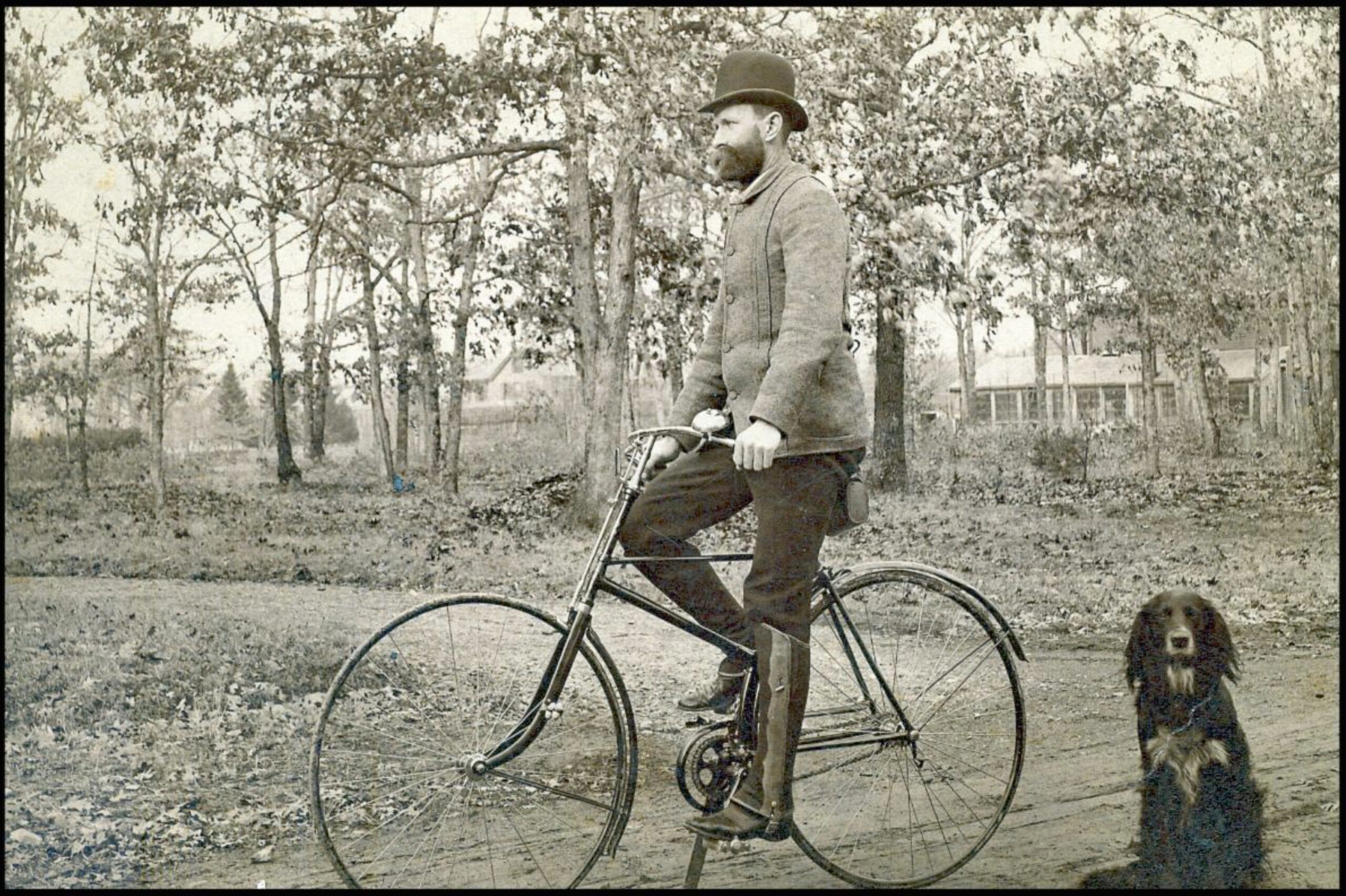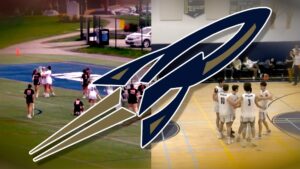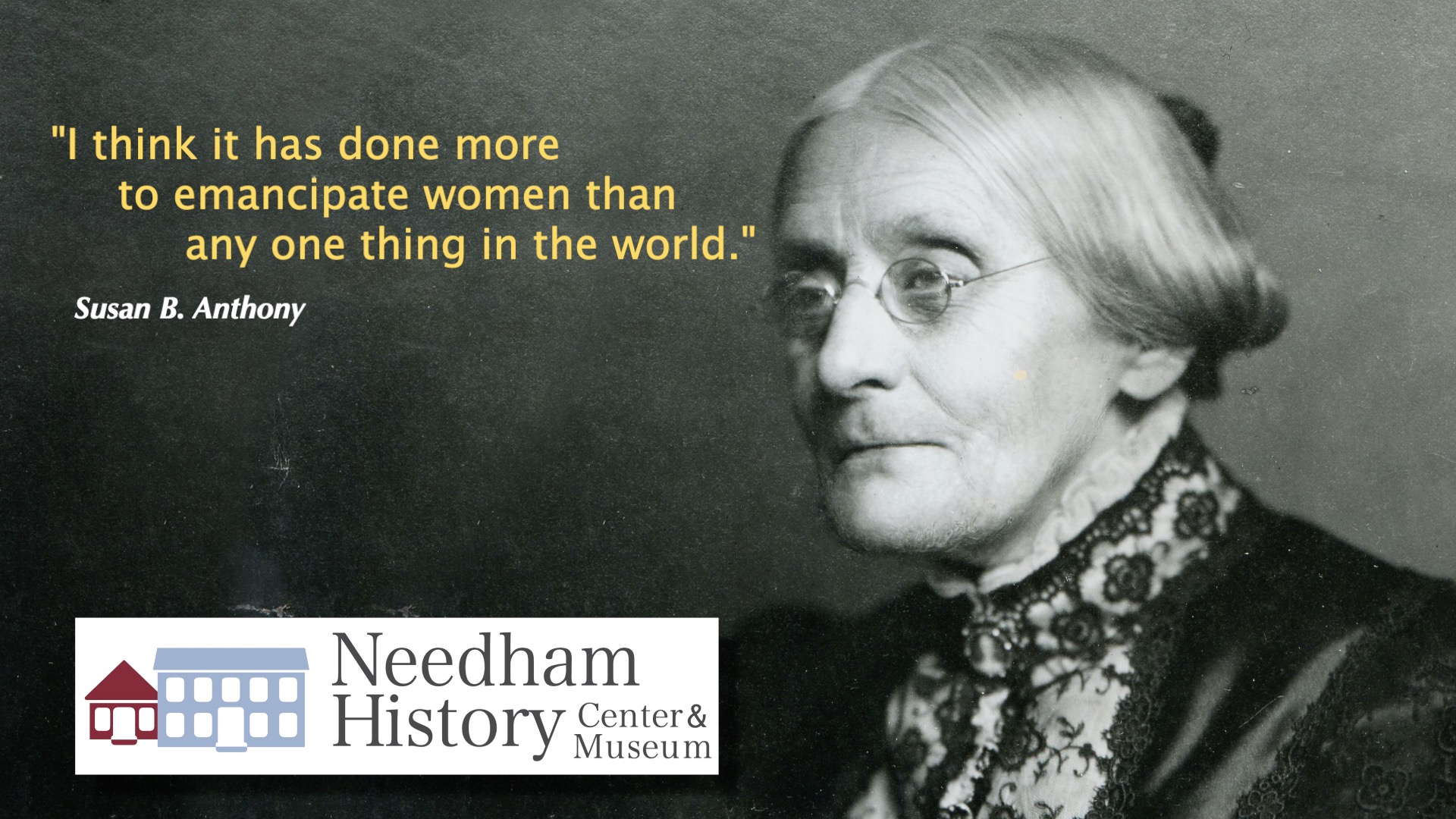
Needham History: Freedom on Two Wheels
Susan B. Anthony was all for it.
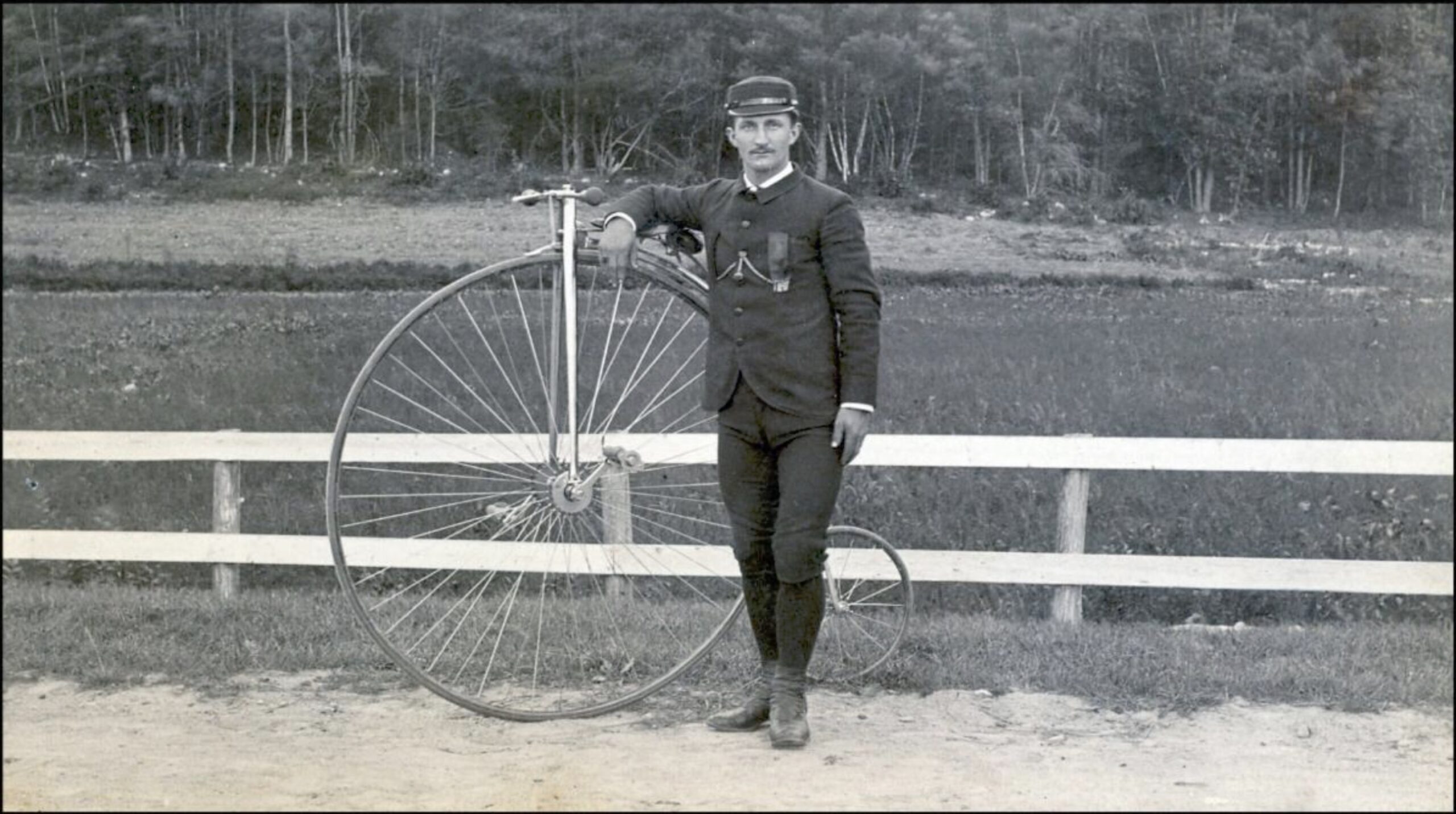 George Freeman with his “all-nickel” 1880s Columbia bike; the special nickel trim would have been expensive. Freeman was an organizer and the Treasurer of the Highlandville Bicycle Club (The “Comets”). He has a uniform and a ribbon/medal, which shows that he was a competitive bike racer.”
George Freeman with his “all-nickel” 1880s Columbia bike; the special nickel trim would have been expensive. Freeman was an organizer and the Treasurer of the Highlandville Bicycle Club (The “Comets”). He has a uniform and a ribbon/medal, which shows that he was a competitive bike racer.”
Freedom on Two Wheels
I drive frequently into Brookline along Beacon Street, and that town has committed significant resources (and road space) to creating dedicated bike lanes, shared-bike kiosks, and the like. More and more, people are abandoning their cars or public transportation and taking to their bikes for either transportation or recreation. Notice every Sunday in Needham, when bikers come out in numbers along the more scenic roads.
Several trends – personal fitness, COVID avoidance, the desire for a cleaner environment – have converged to elevate bike riding from a recreational activity to an increasingly- important source of personal transportation. As municipalities plan for future growth, bike lanes and car-free road access have become a mandatory part of the planning.
This has been a while in coming – bikes have been a socially progressive form of transportation for well more than a century, but their access to the roads was increasingly shunted aside in favor of cars. The first bikes date to the early 1800s, but they became more affordable and widely available later in the century, the 1870s and after. The 1870s also saw the beginnings of the automobile, but bikes were more practical and affordable. For people who mostly walked everywhere, they were a new and speedy means of conveyance. For women, they represented independence of movement (Susan B. Anthony advocated for all women to learn to ride).
And, of course, Needham was there at the start. Needham had two bike manufacturing companies – the Springfield Cycle Manufacturing Company, and its successor, the Union Cycle Manufacturing Company. Springfield built bikes in the old hinge factory on Rosemary Lake from about 1887 to about 1890. They made both high-wheel and modern bikes. The building belonged to the Carter knitting company, but they leased it to Springfield. Springfield Cycle was based in Springfield, MA; the Needham site was a factory.
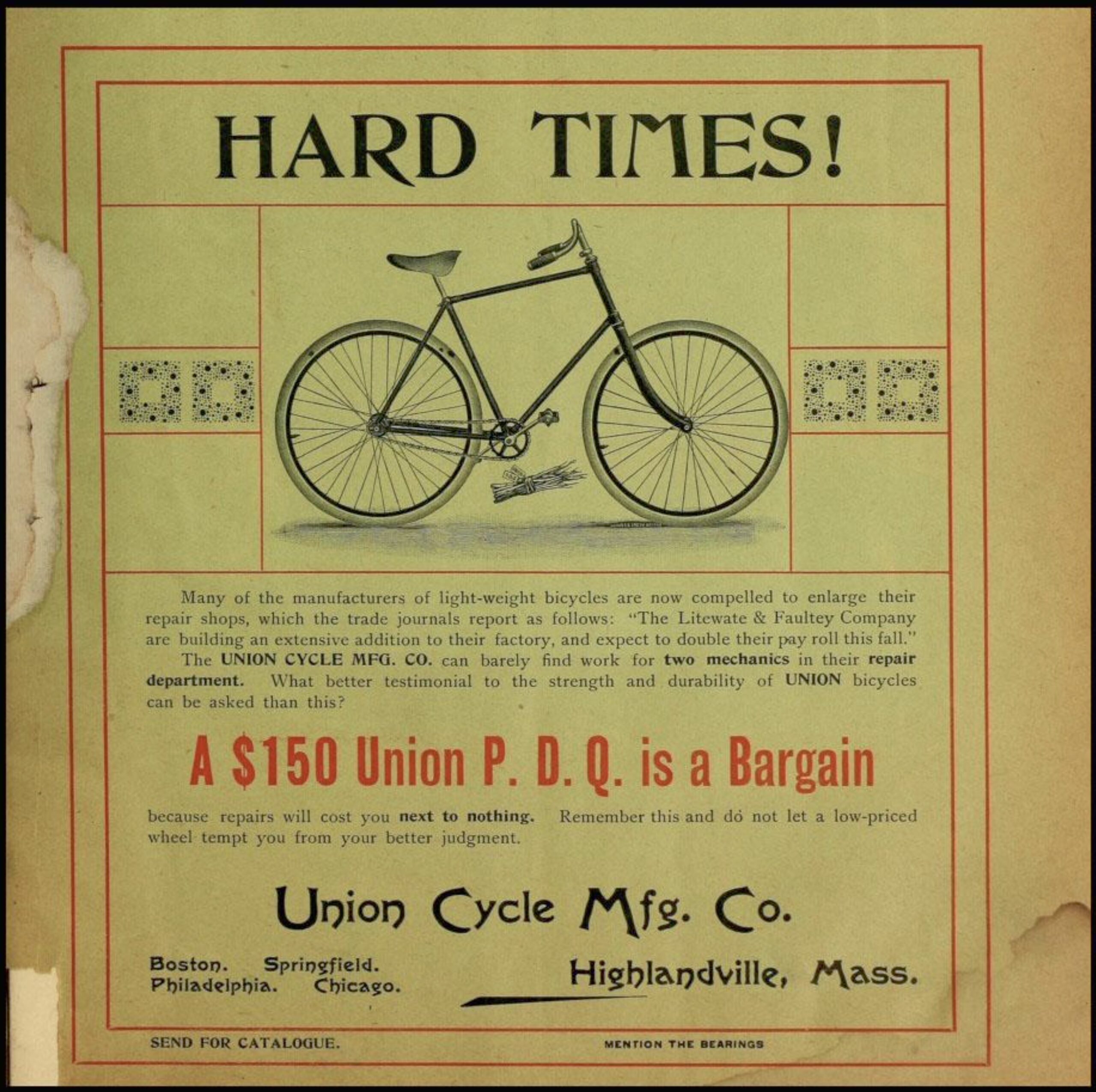
After Springfield closed in Needham in 1890, Union Cycle took over the mill (again leased from Carter’s) and built bikes there until the company moved in 1902. In 1894 they expanded the factory, adding two large wings for machine shops and finishing works. Union’s bikes were more modern, with two equal-sized wheels. Union Cycle made some of the most innovative bikes of the time, with a unique process for building a strong and sleek frame, and with improved front and rear suspensions. And they were not cheap – up to several thousand dollars in current value. In its ads, Union noted this as an advantage – proof that their bikes were better-made than the cheaper competition –
“A $150 Union PDQ is a Bargain, because repairs will cost you next to nothing. Remember this and do not let a low-priced wheel tempt you from your better judgment. Many of the manufacturers of light-weight bicycles are now compelled to enlarge their repair shops… The UNION CYCLE MFG. CO. can barely find work for two mechanics in their repair department. What better testimonial to the strength and durability of UNION bicycles can be asked than this?”
In addition to being landlords, the Carter family had additional interests in
bicycling. William Henry Carter, son and successor to old William Carter, was a competition bike racer (he rode a Union). WH was an avid sportsman, and played state- league cricket for about 20 years, in addition to bike racing. He and his brother Horace also sold bikes – “Unions, and only Unions” – at their Carter Brothers store. Carter Brothers was on the corner of Highland Avenue and West Street (later the Calvert’s location; now Carewell/VinoDivino). They mostly sold Carter’s knit goods, but also sold used and new Union bikes for men and women.
Of course, Springfields and Unions were not the only bikes in Needham. Many manufacturers, both in the US and England, had sales outlets in the Boston area. Photos in our collection also show bikes made by Columbia, Humber, Singer and Bayliss-Thomas. There were also independent bike repair shops and equipment suppliers, like F.M. de Lesdernier (Bicycle Sundries & Repairs) on the corner of Highland Avenue and Mellen Street. And cycling clubs, where enthusiasts (racing or casual) could get together to compare their machines and tall tales. The Needham Chronicle in an article from the 1880s reported that “The Highlandville [Needham Heights] Bicycle Club is a sure thing now, having been in existence since Wednesday night. Some thirteen of the young men in this village have purchased machines and our streets seem to be alive in the evening with riders on their fascinating steeds.” The Highlandville club was known as The Comets. The largest and best-known bicycle club was affiliated with Union Cycle – the Union Rovers.
As 1900 approached, bikes became more abundant and less pricey. When bikes show up in photos from the 1870s and 80s – especially the expensive high-wheelers – they are associated with competition or showing off (as in, part of the family portrait). By 1900, bikes are more domestic – leaning against the fence in a workyard, or being ridden by a young boy. Cars would not become common in Needham until after the First World War, and they ruled the road for a century. But now in the new century, bikes are again reclaiming their share.
(Many thanks to Joe Breeze, Curator at the Marin Museum of Bicycling / Mountain Bike Hall of Fame in Fairfax, CA for starting a conversation about Union Cycle a few summers ago, and for identifying the various bikes in our pictures.)
 |
Gloria Polizzotti Greis is the Executive Director of the Needham History Center & Museum. For more information, please see their website at www.needhamhistory.org. |
